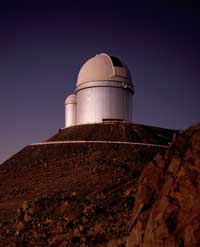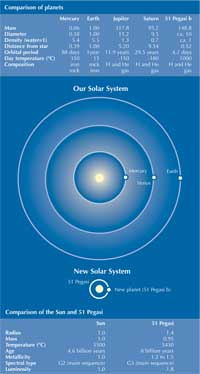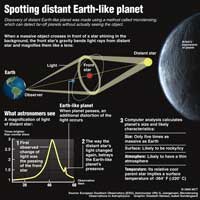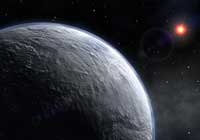Are there Earth-like planets around other stars? Understand article
Uffe Gråe Jørgensen from the University of Copenhagen, Denmark, describes the search for Earth-like planets elsewhere in our galaxy.

Silla Chile
Image courtesy of ESO
There are 100 billion stars in our galaxy, the Milky Way. Many of them are quite similar to our star, the Sun. Does that mean that there are millions or billions of planets like Earth in our galaxy? Maybe even planets with life like us? Until recently, astronomers had only been able to spot planets quite unlike those in our own Solar System, but in August 2005 our group discovered the first planet outside our Solar System which might have formed and developed in the same way as Earth.
Scientists believe that our own Solar System formed from a big interstellar cloud that collapsed 4.6 billion years ago. Most of the cloud became the Sun, but because the cloud was rotating, a small fraction of it was forced into a flat disk of gas and dust around the newborn Sun. In the outer part of the disk, far away from the Sun and beyond the present-day orbit of Jupiter, it was cold enough for water to form ice crystals and snowflakes. Just like on a cold winter day, it was snowing out there – but it snowed for millions of years. Colliding snowflakes and dust grains slowly became larger clumps of solid material, a bit like dirty snowballs. Once the first clump grew larger than 15 times the mass of Earth, its gravity dragged in the surrounding gas. In this way, the clump transformed itself into a gigantic planet with a solid core surrounded by huge amounts of compressed gas – we call it a gas planet, even though it also has a solid core of ice with small amounts of stone and metal inside. Jupiter, which is the largest gas planet in our Solar System, contains 300 times more mass than Earth, mainly in the form of compressed hydrogen and helium gas.
In the inner part of the disk, nearer the Sun, however, it was too warm for water to form snow. Instead, water stayed in the cloud, just like it stays in the air on a warm summer day. Only the very rare dust particles made of stone and metal could form solid clumps, and therefore the inner planets, Mercury, Venus, Earth, and Mars, became ‘small’ stone clumps (with an iron core), just like the rocky surroundings of Earth with which we are familiar. The lack of snow in the inner part of the cloud prevented the planets in this region from ever becoming huge gas planets like Jupiter. The small amount of water and atmosphere we have today came later to Earth (in a very complicated way, which is still a subject of intense debate between scientists), but it is next to nothing compared with the huge gas masses of Jupiter and the other gas planets.
It was therefore a big surprise when the first planet discovered around another star, in 1995, was a gigantic gas planet in a tiny orbit. At first glance, the discovery of this planet, 51 Pegasi b, strongly conflicted with our understanding of how planetary systems should form, as we had learned from studying our own Solar System: large gas planets in large orbits and small, Earth-like, solid planets in smaller orbits. However, the method that had been used to find planets (see below) was sensitive to such ‘strange’ planets.
Today, it is generally believed that these large gas planets formed in the same way as did Jupiter and Saturn, but then slowly drifted inwards, towards the star they orbit. If Jupiter had behaved like that in our Solar System, it would most likely have engulfed our small Earth into its huge interior while passing us, and there would be no Earth today. But the orbits of all the planets in our Solar System are remarkably stable. We do not know if this stability is normal for planetary systems, or if it is unique to our Solar System. Without it, conditions in our system would most likely have changed too drastically and too often for our fragile life to have survived. For example, the stability of the outer planets caused more than a thousand billion comets to be removed from the inner Solar System shortly after Earth was formed. If they had still been around today, regular collisions with them would most likely have removed our atmosphere and evaporated the oceans, preventing life from gaining a foothold. Maybe we exist in our Solar System precisely because it is the only place in the Universe that allows life to survive and develop over biological time-scales (i.e. billions of years).

Mercury, Venus, and Earth
with the orbit of 51 Pegasi b,
the first discovered exoplanet
If a planet orbits a star other than the Sun, we call it an extrasolar planet, or an exoplanet. Since 1995, scientists have discovered almost 200 exoplanets. Most of them (including the first) have been discovered using the radial velocity technique, which looks for changes in the position of spectral lines from the star and is most sensitive to very big planets in very small orbits. Most of the many other techniques that are now used to search for extrasolar planets are also mainly sensitive to planets that are very different from the planets in our Solar System. Therefore we continue to find mainly ‘unexpected’ planets. We find large gas planets in small orbits where they cannot have formed, or small solid planets in ultra-small orbits where they cannot have formed, or extremely large and bright planets in extremely large orbits around very small stars, and so forth. But this does not necessarily mean that even Earth-like planets are rare in the Universe. We just need to look for them with other methods. The main difficulty in detecting Earth-like exoplanets around distant stars is that Earth is small (so its light is obscured by the light of the star it orbits) and at the same time in a relatively large orbit (so its star must be observed for a very long time before any periodic movement can be detected).
For some years, our group has been working on the implementation of a method called microlensing, which is particularly sensitive to planets in orbits resembling that of Earth, and those with masses as small as that of Earth. When one star passes almost directly in front of another, its gravitational field will bend the light from the background star. The front star will then act as a magnifying lens, because it causes the light from the background star to reach us from several directions at the same time, thereby making it appear brighter. If the front star is alone (i.e. there is no planet moving around it), its gravitational field will be symmetric, and the brightness of the background star will therefore first increase, as the stars approach one another, and then decrease, as the two stars slide away from one another again. In this case, the light curve is symmetric in time. If, on the other hand, the front star is orbited by a planet, the gravitational field will be asymmetric. The brightness of the background star will then decrease in a way different to how it increased: the light curve will be asymmetric. It is these asymmetries that we look for. Typically the front star will be a star somewhat smaller than the Sun (there are simply more of these in our galaxy) and the background star will be a cool, red giant star (easiest to spot because they are very bright).

Image courtesy of Knight
Ridder / Tribune Information
Services
At Las Campanas observatory in Chile, a Polish team called OGLEw1 monitors about 100 million stars, and alerts the scientific community when any of them become microlensed. In a collaboration between telescopes at the European Organisation for Astronomical Research in the Southern Hemisphere (ESO) in Australia and South Africa, we have formed the PLANETw2 group, which monitors the best of the OGLE alerts 24 hours a day.
During the most critical stages, we observe a given star every few minutes. In this way, we have resolved the light curves of more than 200 microlensing events during the last three years. From the many light curves that did not show any planetary signs, we conclude that Jupiter-Saturn-like planets (i.e. large gas planets) in Jupiter-Saturn-like orbits (i.e. large orbits) are rare in our galaxy. In other words, the kinds of planets that stabilised our own Solar System over biological time-scales seem to be uncommon in the Universe – a central conclusion for estimating the odds of finding life like ours elsewhere in the galaxy.

exoplanet OGLE-2005-
BLG-390Lb
Image courtesy of ESO
On 9 August 2005, however, the Danish telescope at the ESO observatory at La Silla, Chile, spotted the first signs of the kind of light-curve asymmetry we had been looking for, suggesting the presence of an orbiting planet. We immediately notified our collaborators, both inside and outside our team, and over the next six hours, four telescopes in Chile, New Zealand and Australia confirmed the nature of the deviation. After three months of intensive modelling of the light curve, we were finally convinced that we had seen the signal from the smallest exoplanet that was ever observed, and in January 2006, we announced the discovery in Nature (Beaulieu et al., 2006).
The new planet has the name OGLE-2005-BLG-390Lb, or, in short, OB05390. It is five times the mass of Earth (i.e. it is more ‘Earth-like’ than Mars, which is one-tenth Earth’s mass), and circles a star 22 000 light-years away, in an orbit three times the size of Earth’s orbit. This makes it the only known exoplanet which, according to theories, is made of solid rock, like Earth, and orbits its star at a distance at which it could also have formed. It may be the first extrasolar system ever seen in which the planets are in stable orbits, and where conditions for life are stable over biological time-scales, as in our own Solar System.
Recent developments on exoplanets at ESO
The discovery at La Silla of an exoplanet of five times the mass of Earth is the latest achievement in a long series of breakthroughs made with ESO’s telescopes. The ESO La Silla Paranal Observatory, with its large instruments equipping the Very Large Telescope (Pierce-Price, 2006) and the various smaller telescopes, is very well equipped for the study of exoplanets, with instruments for adaptive optics imaging, high resolution spectroscopy and long-term monitoring. A list of the most recent of these achievements is given below.
2002: Discovery of a dusty and opaque disc in which planets are forming or will soon form, surrounding a young solar-type star. This disc is similar to the one in which astronomers think the Earth and other planets in the Solar System formed. More details.
2004: Confirmation of the existence of a new class of giant planet. These planets are extremely close to their host stars, orbiting them in less than two Earth days, and are therefore very hot and ‘bloated’. More details.
2004: Discovery of the first possible rocky exoplanet, an object 14 times the mass of Earth. More details.
2004: First image achieved of an exoplanet, leading the way for a more direct study of exoplanets. For more details, see here and here.
2004: Ingredients for the formation of rocky planets discovered in the innermost regions of the proto-planetary discs around three young stars. This suggests that the formation of Earth-like planets may not be so unusual. More details.
2005: Discovery of a planet of mass comparable to Neptune around a low-mass star, the most common type of star in our Galaxy. More details.
2006: Discovery of the smallest known exoplanet, with only five times the mass of Earth (this paper). More details.
2006: Detection of three Neptune-like planets, each of mass between ten and 20 times that of Earth, around a star that also possesses an asteroid belt. Of all known systems, this is the most similar to our own Solar System. More details.
2006: Observations show that some objects with several times the mass of Jupiter have a disc surrounding them and may form in a similar way to stars. It thus becomes much more difficult to define precisely what a planet is. More details.
Henri Boffin, ESO
References
- Beaulieu JP et al. (2006) Discovery of a cool planet of 5.5 Earth masses through gravitational microlensing, Nature 439: 437-440. doi:10.1038/nature04441.
Download the article free of charge here, or subscribe to Nature today: www.nature.com/subscribe - Pierce-Price D (2006) Running one of the world’s largest telescopes, Science in School 1 56-60
Web References
Resources
- California & Carnegie Planet Search, a regularly updated site with important information about exoplanets
- The Extrasolar Planets Encyclopaedia
- A recent in-depth and technical review of the subject:
- Marcy G et al. (2005) Observed properties of exoplanets: masses, orbits, and metallicities. Progress of Theoretical Physics Supplement 158: 24-42.
- Further information about the research of Uffe Gråe Jørgensen and his colleagues is available here.
Institutions
Review
This article provides up-to-date information on developments in the field of extrasolar planet discovery. It details the discovery of a new Earth-like planet orbiting a star 22 000 light-years away using a new technique called microlensing – the detection of asymmetry in the gravitational lensing of light from a distant star as it passes behind a closer star – instead of the usual search for a ‘wobble’ in a star’s spectral lines.
The article is of interest mainly to those studying or teaching astronomy or relativity (as an application of Einstein’s ideas of gravitational lensing) to update their subject knowledge or for general-interest reading. The article itself contains no pedagogical content. The clear language and interesting subject, however, mean that it could be used with comprehension questions even for lower age groups (e.g. 15-16 year-olds). The article could also be used with more advanced students as the beginning of a research topic.
Mark Robertson, UK





